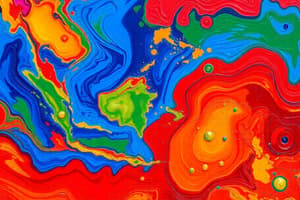Podcast
Questions and Answers
Asia experiences a variation in climatic conditions due to different ______, mountains, and deserts.
Asia experiences a variation in climatic conditions due to different ______, mountains, and deserts.
oceans
Areas located away from oceans experience extreme conditions and ______ climates.
Areas located away from oceans experience extreme conditions and ______ climates.
continental
The monsoons are a wind system that reverses its direction every ______ months.
The monsoons are a wind system that reverses its direction every ______ months.
six
Monsoons usually flow from the sea to land in the ______.
Monsoons usually flow from the sea to land in the ______.
The summer monsoon and the winter monsoon determine the climate for most of ______ and South-East Asia.
The summer monsoon and the winter monsoon determine the climate for most of ______ and South-East Asia.
By June, most parts of Asia experience an average temperature of ______°C.
By June, most parts of Asia experience an average temperature of ______°C.
The winds carrying moisture-bearing clouds cause heavy ______ in countries located in southern Asia.
The winds carrying moisture-bearing clouds cause heavy ______ in countries located in southern Asia.
Monsoons are most often associated with the ______ Ocean.
Monsoons are most often associated with the ______ Ocean.
The deserts of Central Asia include the Gobi and ______.
The deserts of Central Asia include the Gobi and ______.
Temperate grasslands are also referred to as ______.
Temperate grasslands are also referred to as ______.
Istanbul is located in the ______ region.
Istanbul is located in the ______ region.
Tundra means 'marshy ______' in Russian.
Tundra means 'marshy ______' in Russian.
Arctic tundra is found in the ______ Pole.
Arctic tundra is found in the ______ Pole.
Coniferous trees have needle-like ______.
Coniferous trees have needle-like ______.
The deciduous vegetation in Korea is known as the Central Korean ______.
The deciduous vegetation in Korea is known as the Central Korean ______.
Tropical monsoon forests experience a heavier ______ than tropical deciduous forests.
Tropical monsoon forests experience a heavier ______ than tropical deciduous forests.
Sparse plant cover in deserts is often moisture-combating and ______.
Sparse plant cover in deserts is often moisture-combating and ______.
Equatorial rainforests are found in Malaysia, Indonesia, and southern ______.
Equatorial rainforests are found in Malaysia, Indonesia, and southern ______.
Trees like mahogany and ______ are characteristic of equatorial rainforests.
Trees like mahogany and ______ are characteristic of equatorial rainforests.
Insects and millions of migratory ______ come to feed in the tundra during summer.
Insects and millions of migratory ______ come to feed in the tundra during summer.
The ______ vegetation is prevalent at the top of tall cold mountains.
The ______ vegetation is prevalent at the top of tall cold mountains.
The ______ region experiences long, cold winters and short, cool summers.
The ______ region experiences long, cold winters and short, cool summers.
Animals such as polar bears, reindeer, and ______ are found in the tundra.
Animals such as polar bears, reindeer, and ______ are found in the tundra.
Regions near the coast experience a ______ climate influenced by land and sea breezes.
Regions near the coast experience a ______ climate influenced by land and sea breezes.
The ______ region is characterised by warm summers and cool winters.
The ______ region is characterised by warm summers and cool winters.
The ______ winds from the Indian Ocean bring heavy rains during the summer months to India.
The ______ winds from the Indian Ocean bring heavy rains during the summer months to India.
The ______ region experiences low rainfall and extreme temperatures.
The ______ region experiences low rainfall and extreme temperatures.
The ______ region includes countries such as Japan, North Korea, and South Korea.
The ______ region includes countries such as Japan, North Korea, and South Korea.
Central Siberia falls under the ______ region, known for cold winters.
Central Siberia falls under the ______ region, known for cold winters.
In the winter monsoon season, most of Asia does not experience ______.
In the winter monsoon season, most of Asia does not experience ______.
The Himalayas stop the cold Siberian winds from entering regions to its ______.
The Himalayas stop the cold Siberian winds from entering regions to its ______.
Asia experiences a vast latitudinal extent, ranging from ______ degrees South to 80 degrees North.
Asia experiences a vast latitudinal extent, ranging from ______ degrees South to 80 degrees North.
In the equatorial region, high rainfall is seasonally well-______ throughout the year.
In the equatorial region, high rainfall is seasonally well-______ throughout the year.
The ______ of Asia has a definite dry and wet season.
The ______ of Asia has a definite dry and wet season.
Colder ocean currents like the ______ lower coastal temperatures along Japan.
Colder ocean currents like the ______ lower coastal temperatures along Japan.
Regions far from the sea experience extreme ______, resulting in very hot summers and cold winters.
Regions far from the sea experience extreme ______, resulting in very hot summers and cold winters.
During the cooler months, the wind direction changes and goes from the land towards the ______.
During the cooler months, the wind direction changes and goes from the land towards the ______.
Flashcards are hidden until you start studying
Study Notes
Climatic Variation in Asia
- Asia's climate varies significantly due to influences from oceans, mountains, deserts, and wind patterns.
- Regions distant from oceans experience extreme continental climates, while coastal areas enjoy more moderate maritime climates.
- Mountain ranges can block rain-bearing clouds and cold winds, affecting regional climates.
Monsoon Influence
- Monsoons reverse direction bi-annually, flowing from the sea to land in summer and vice versa in winter.
- They are critical for determining wet and dry seasons, especially in tropical regions and are primarily associated with the Indian Ocean.
- The summer monsoon brings heavy rainfall to India, Sri Lanka, Myanmar, and parts of Southeast Asia, averaging temperatures of 32°C during peak months.
Seasonal Dynamics
- Summer monsoons arise as hot air over land creates low pressure, drawing moisture-laden winds from the seas.
- In winter, slanting sunlight cools the land, creating high pressure that drives dry winds toward the oceans, leading to minimal rain in many areas.
- Regions like South-East Asia and Japan may experience winter monsoons due to cold, dry air absorbing moisture over oceans.
Factors Affecting Climate
- Asia's vast latitudinal span (10°S to 80°N) results in diverse climatic conditions ranging from equatorial to arctic climates.
- Proximity to the sea influences climate, with coastal areas experiencing maritime conditions while inland areas experience extreme temperatures.
- Mountain ranges often obstruct cold winds and rainfall, impacting regional climates, as noted with the Himalayas and Aravalli Hills.
Ocean Currents
- Ocean current temperatures influence regional climates; warm currents elevate coastal temperatures, while cold currents lower them.
Major Climatic Regions of Asia
- Tundra Region: Long, cold winters and short summers with snow cover, found mainly in northern Asia.
- Taiga Region: Cold winters and warm summers prevalent in Central Siberia, characterized by coniferous forests.
- Temperate Region: Warm summers and cool winters, experiencing both rain and snowfall, includes parts of Northeast Asia.
- Monsoon Region: Distinct wet and dry seasons; significant rainfall during summer monsoons, particularly in the Indian subcontinent.
- Equatorial Region: High, well-distributed rainfall and minimal temperature variation; includes Indonesia and Malaysia.
- Desert Region: Extremely low rainfall (less than 250mm) and high temperature variation, found in Central Asia and surrounding areas.
- Temperate Grasslands (Steppes): Cold winters and warm summers with short grass expanses; located north of deserts.
- Mediterranean Region: Hot, dry summers and cool, wet winters; notable in Turkey, Syria, and neighboring coastal areas.
Natural Vegetation and Wildlife
- Vegetation regions reflect climate variations, including tundra, taiga, deciduous forests, tropical monsoon forests, and desert vegetation.
- Tundra: Cold, treeless plains with lichens and mosses; inhabited by polar bears and migratory birds.
- Taiga: Dominated by coniferous trees like pine and fir; wildlife includes sable mink and bears.
- Deciduous Vegetation: Covers parts of China, Russia, and Japan; includes various hardwood species and diverse fauna.
- Tropical Deciduous: Found in India and Southeast Asia; trees shed leaves in dry seasons and support diverse wildlife.
- Desert Vegetation: Sparse plant cover with moisture-resistant species; inhabited by camels and reptiles.
- Equatorial Rainforest: Dense hardwood forests with limited sunlight penetration; rich in biodiversity including monkeys and various reptiles.
Studying That Suits You
Use AI to generate personalized quizzes and flashcards to suit your learning preferences.




